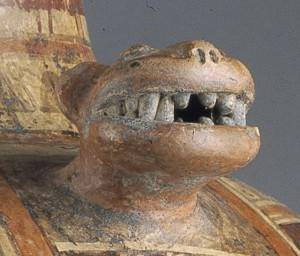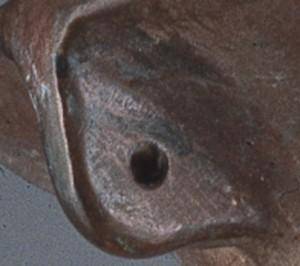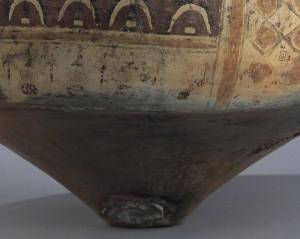Urpu with Insect Design
We don’t know who crafted this jug, but because of its shape, we know that the artist lived during the time of the Inca Empire. Vessels such as these were made in both large and small sizes. The artist formed the jug out of clay, smoothed the surface, and then decorated it with colored slips that were made up of a mixture of clay, water, and mineral pigments. Finally, the surface of the vessel was burnished or polished before firing.
Ceramics made by craftsmen in the workshops of Cuzco, the Inca capital, were highly prized as tangible evidence of imperial prestige. Local imitations were produced throughout the vast territory conquered by the Inca, which extended from Ecuador in the north to Chile in the south. Numerous ethnic groups and independent political entities were not only conquered but also effectively integrated into a centrally administered political and economic system.
Vessels of this shape were used to hold liquids, especially chicha, a kind of beer made from corn. Very large vessels like this one would probably have been used on festive, ceremonial occasions. In the Inca Empire, commoners paid tribute to their local lords, religious authorities, and imperial administrators in the form of labor and military service. These authorities reciprocated with food, clothing, and other necessities. Most importantly, leaders held feasts for their tributaries, providing copious amounts of chicha. Serving this beer from an elaborately decorated jar such as this emphasized the wealth and generosity of the Inca state. Inca vessels of this shape are called aryballos because of their resemblance to similarly shaped ancient Greek ceramics.
Details

Painted Decorations
The painted decorations on this vessel are particularly elaborate. Red and black flamingos form lines around the neck. The front of the vessel is divided into three zones: a vertical central panel with a diaper pattern (an all-over diamond-shaped pattern) that is flanked by two horizontally subdivided sections filled with insects and flowers.

The Lug
The lug, found on the vessel’s shoulder at the base of the neck, is shaped like a jaguar head with a toothy mouth.

Ingenious Design
The handles and lug, along with a strap, were used to transport the jug. The strap was looped through one handle, up over the top of the lug, and then down through the other handle. The person carrying the jug used his back for support and tied the two free ends of the strap around his waist.

Holes at the Rim
There are two small holes under the rim of the vessel that would have been used to secure a lid (now missing).

Pointed Base
The pointed base was intended to be set in a depression in a dirt floor.
More Resources
Websites
U.S. State Department, Bureau of Educational and Cultural Affairs
An example of a similar Incan ceramic vase.
Glendale University: History of World Ceramics
A brief paragraph on the Inca Empire and an explanation of how an Incan aryballo is to be carried.
Storage Jar: The Metropolitan Museum of Art Heilbrunn Timeline of Art History
A brief explanation of an Inca aryballo.
NOVA: The Lost Incan Empire
A PBS website with an overview of the Inca civilization.
Books
Bankes, George. Peruvian Pottery. Aylesbury: Shire Publications, Ltd., 1989.
A chronology of the ceramic traditions of Peru.
D’Altroy, Terence N. The Incas. Oxford: Blackwell Publishers, 2002.
A detailed discussion of Inca culture. Pages 304-309 look at pottery and include a couple of helpful images of the aryballo in use, as well as additional ceramic wares.
Donnan, Christopher B.. Ceramics of Ancient Peru. Los Angeles: Regents of the University of California, 1992.
A breakdown of ancient Peruvian ceramics by period/empire. Pages 107-117 discuss Cuzco Inca ceramics, like the Denver Art Museum example.
McEwan, Gordon F. The Incas: New Perspective. Santa Barbara, CA: ABC-Clio, Inc., 2006.
A detailed discussion of the Inca Empire. Pages 161-164 specifically cover pottery.
Morris, Craig, and Adriana von Hagen. The Inca Empire and its Andean Origins. New York: Abbeville Press Publishers, 1993.
An art-focused survey of the Inca Empire and its origins.
Children's Books
Braman, Arlette N. The Inca: Activities and Crafts from a Mysterious Land (Secrets of Ancient Cultures). Hoboken, NJ: Jon Wiley & Sons, Inc., 2004.
A book full of activities which help kids ages 9-12 learn about several aspects of Inca culture.
Calvert, Patricia. The Ancient Inca. Franklin Watts, 2005.
For grades 5-8, this book is an overview of the Inca peoples, with several pictures of artifacts and archeological sites.
Funding for object education resources provided by a grant from the Morgridge Family Foundation. Additional funding provided by the William Randolph Hearst Endowment for Education Programs, and Xcel Energy Foundation. We thank our colleagues at the University of Denver Morgridge College of Education.
The images on this page are intended for classroom use only and may not be reproduced for other reasons without the permission of the Denver Art Museum. This object may not currently be on display at the museum.
